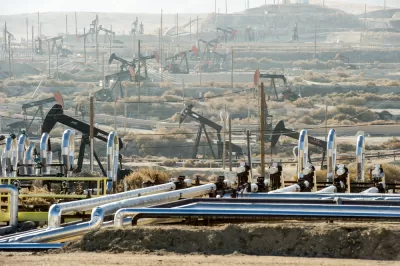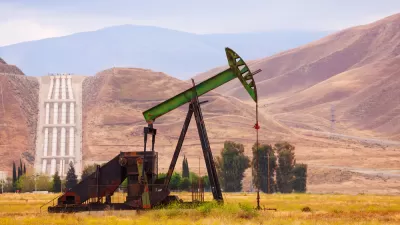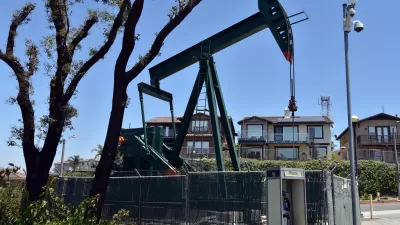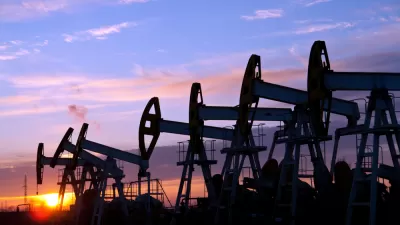Almost 80% of oil extraction in the nation's sixth largest oil-producing state occurs in Kern County. Supervisors see the California governor's climate plan to reduce oil production as a threat to the county's economic well-being.

In 2014, Kern County, lying at the southern end of the Central Valley, was the nation's top oil-producing county, and California was the third-largest oil-producing state after Texas and North Dakota. But oil production has been declining in the Golden State since 1985, and now counties in North Dakota and New Mexico claim the two top spots, while New Mexico, Oklahoma and Colorado are the third, fourth, and fifth-largest producers, respectively.
However, petroleum remains central to the county's economy and tax base, which explains the Board of Supervisors' strong response to recent actions taken by the Newsom administration.
In three articles, John Cox, business editor-writer at The Bakersfield Californian, reports on actions taken by the Board of Supervisors at their Dec. 10 meeting, the response from environmental justice advocates, and an earlier piece where economists comment on Newsom's supply-side approach to climate policy.
"Tuesday's board action appears to be the first political push-back against talk of 'managing the decline' of California oil production," reports Cox (source article).
The board voted 5-0 to invite the industry to come make a public presentation about the impacts of new oil regulations, organize a coalition to tell Sacramento about the industry's local importance and consider declaring an "economic crisis" if facts support it [See "Summary of Proceedings (pdf)," agenda #7].
"The arrogance and hypocrisy of this administration to deny Californians access to our own natural resources is appalling," said the measure's author, Second District Supervisor Zack Scrivner.
Environmentalists want a seat at the table
"Members of a coalition of environmental justice groups say they feel overlooked amid a campaign focused explicitly on supporting Kern's most important industry," reports Cox on Dec. 12. "They assert that drilling for petroleum endangers the health of poor and largely immigrant neighborhoods living near local oil fields."
[Rosanna Esparza, a local gerontologist researching the impact oil and gas drilling has on people 65 years and older] and Juan Flores, a community organizer for the Delano-based Center on Race, Poverty and the Environment, said it's important that county supervisors represent not only the oil industry but also the communities who live near and are affected by oil production.
Flores said it might be premature to end oil production altogether, considering the large number of workers the industry employs locally. But he said it might be appropriate to establish a buffer between production areas and nearby homes and other sensitive sites.
In fact, the second of the three initiatives announced by the California Department of Conservation on Nov. 19 will consider just that:
The rulemaking will consider a range of protective measures, including prohibiting oil and gas activities within close proximity of homes, schools, hospitals, and parks. The pre-regulatory process will begin in 2020, with new/modified rules anticipated later that year.
Last month, Cox reported on the reactions by economists on Newsom's dual approach to climate change – tackling both supply and demand.
"If California consumers continue to demand the same amount of gasoline, it will just come from elsewhere," said Stanford University environmental economist Charles D. Kolstad..."It would be far more effective to take steps to reduce California oil consumption, which is one of the consequences of the state's pushing electric vehicles," he wrote.
Cox points to the decreasing amounts of in-state oil, and increasing imported oil, transported to California's 12 refineries that supply the state's light and heavy-duty vehicles the gasoline and/or diesel fuel. In 1998, almost 50% came was transported from the state's oil fields via pipelines, with the remainder coming via ship from abroad (only 16%) and Alaska (34%). Last year, the supplies from the state's oil fields dropped to 31% while foreign sources supplied 58%. Unlike natural gas pipelines, California has no oil interstate pipelines.
One of the main studies supporting a supply-side approach can be found in a briefing paper released in February 2018 by the Stockholm Environment Institute mainly based on global oil prices and supply and demand forces.
"Even though other regions would likely increase production somewhat, the authors estimate that global oil use would still drop by 0.2-0.6 barrels for every barrel that California does not produce," reported Nicholas Kusnetz for InsideClimate News.
In addition, the briefing paper argues that emissions from oil and gas extraction, which accounted for 4.1 percent of greenhouse gas emissions in 2017 (see California Air Resources Board chart [pdf] on pg. 6) would be reduced, though technically they would be "outsourced." Tackling oil demand, on the other hand, would address the 41 percent of emissions that result from transportation.
The SEI researchers also noted that "due to the widespread use of enhanced recovery techniques, such as energy-intensive steam flooding, California’s most productive oil fields are more GHG emissions-intensive than the average blend of crude oil" [see page 4 (pdf)].
Can California be a climate leader and remain a major oil producer? One of the study's authors, Peter Erickson, was interviewed in a New York Times article in 2017 about just that topic. Norway, which enjoys the world's largest per capita adoption of electric vehicles, is also a significant exporter of oil.
Severin Borenstein with the Energy Institute at the Haas School of Business UC Berkeley noted the uncertainty of the paper's finding in an op-ed in the Los Angeles Times, and pointed to a second downside of the strategy.
It will cause a huge transfer of wealth from consumers to producers. Remember, the way that the policy reduces emissions is by raising the price of oil, which means all consumers pay more and all producers (except for those curtailed in California) make more money.
Severance tax
Some supply-side side approaches to climate policy really do make economic sense. A state-wide severance tax, strongly opposed by the oil industry, would shift revenue from consumers to programs that benefit California, rather than foreign producers. California is the only oil-producing state lacking a statewide severance tax. The most recent attempt, SB 246, introduced last February by Sen. Bob Wieckowski (D-Fremont), has yet to be heard in committee.
Related in Planetizen:
- New Oil and Gas Drilling in California May Be Subject to Moratorium, December 9, 2019
- The Case for an Oil Severance Tax, September 21, 2015
Hat tips to Rosanna Esparza and David McCoard.
FULL STORY: County supervisors plan to counter governor's actions against California's oil industry

Maui's Vacation Rental Debate Turns Ugly
Verbal attacks, misinformation campaigns and fistfights plague a high-stakes debate to convert thousands of vacation rentals into long-term housing.

Planetizen Federal Action Tracker
A weekly monitor of how Trump’s orders and actions are impacting planners and planning in America.

In Urban Planning, AI Prompting Could be the New Design Thinking
Creativity has long been key to great urban design. What if we see AI as our new creative partner?

King County Supportive Housing Program Offers Hope for Unhoused Residents
The county is taking a ‘Housing First’ approach that prioritizes getting people into housing, then offering wraparound supportive services.

Researchers Use AI to Get Clearer Picture of US Housing
Analysts are using artificial intelligence to supercharge their research by allowing them to comb through data faster. Though these AI tools can be error prone, they save time and housing researchers are optimistic about the future.

Making Shared Micromobility More Inclusive
Cities and shared mobility system operators can do more to include people with disabilities in planning and operations, per a new report.
Urban Design for Planners 1: Software Tools
This six-course series explores essential urban design concepts using open source software and equips planners with the tools they need to participate fully in the urban design process.
Planning for Universal Design
Learn the tools for implementing Universal Design in planning regulations.
planning NEXT
Appalachian Highlands Housing Partners
Mpact (founded as Rail~Volution)
City of Camden Redevelopment Agency
City of Astoria
City of Portland
City of Laramie





























